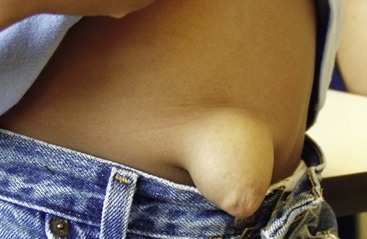Umbilical and Other Abdominal Wall Hernias
Umbilical Hernia
Anatomy
After birth, closure of the umbilical ring is the result of complex interactions of lateral body wall folding in a medial direction, fusion of the rectus abdominis muscles into the linea alba, and umbilical orifice contraction which is aided by elastic fibers from the obliterated umbilical arteries. Fibrous proliferation of surrounding lateral connective tissue plates and mechanical stress from rectus muscle tension may also help with natural closure. Failure of these closure processes results in umbilical hernia. The hernia sac is peritoneum, which is usually very adherent to the dermis of the umbilical skin. The actual fascial defect can range from several millimeters to 5 cm or more in diameter. The extent of skin protrusion is not always indicative of the size of the fascia defect. Frequently, small defects can result in alarmingly large proboscis-like protrusions (Fig. 49-1). Thus, it is important to palpate the actual fascia defect by reducing the hernia to assess whether operative or nonoperative treatment is appropriate.
Incidence
The incidence of umbilical hernia in the general population varies with age, race, gestational age, and coexisting disorders. In the USA, the incidence in African-American children from birth to 1-year-old ranges from 25–58%, whereas Caucasian children in the same age group have an incidence of 2–18.5%.1,2 Premature and low birth weight infants have a higher incidence than full-term infants.3 Infants with certain other conditions, such as Beckwith–Wiedemann syndrome, Hurler syndrome, various trisomy conditions (trisomy 13, 18, and 21), and congenital hypothyroidism, also have an increased incidence as do children requiring peritoneal dialysis.4,5
Treatment
For many years, it has been known that umbilical hernias will close spontaneously. It seems very safe to observe the hernia until ages 3 to 4 years to allow closure to occur. Pressure dressings and other devices to keep the hernia reduced do not enhance the closure process and may result in skin irritation and breakdown. Although dated, a number of studies in both Caucasian and African-American populations showed spontaneous resolution rates of 83–95% by 6 years of age. 6–10 Another study found that 50% of hernias still present at age 4 to 5 years will close by age 11 years.9 One study suggests that hernias with fascial defects greater than 1.5 cm are unlikely to close by age 6 years, whereas other series conclude that even large defects will spontaneously resolve without operation.8,11,12 The primary danger associated with observation therapy is the possibility of incarceration or strangulation. Studies have shown these complications to be quite rare, with an incidence of less than 0.2%.8,12,13 Patients with small fascial defects (0.5–1.5 cm in diameter) appear more prone to incarceration.14
The operative closure of an umbilical hernia is generally straightforward, and can usually be completed as an outpatient procedure. Methods used commonly in the adult, such as prosthetic placement, are almost never needed in the child. The most common method of repair is shown in Figs 49-2 and 49-3






